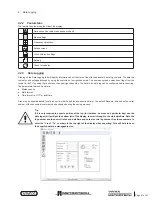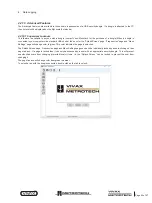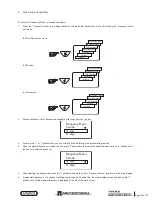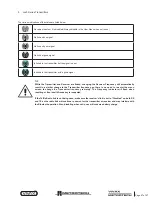
™
Page 47 of 67
5 Loc3 Series Transmitters
5.1.2 Pushbuttons
1
3
4
5
2
1
On/Off control
2
Frequency select
3
Information (Volume, Volts, Ohms, Multi-frequencies LCD
contrast, Bluetooth menu, Frequency menu)
4
Output decrease/Navigate through the menu
5
Output increase/Navigate through the menu
5.1.3 Information Pushbutton
Volume
Voltage
Resistance
Multi Frequency
LCD Contrast
Bluetooth Menu
Frequency Menu
Pushbutton
Pushbutton
Volume
Voltage
Resistance
Multi Frequency
LCD Contrast
Bluetooth Menu
Frequency Menu
Pushbutton
Pushbutton
When the “i” (information) pushbutton is pressed, the display will show the volume level of the audio; use the “+” and “-”
pushbuttons to increase/reduce the volume or turn the beeper off (off, low, medium, then high).
Keep pressing the “i” (information) pushbutton, the display can be toggled to show “voltage”, “resistance” or other functions as
shown in the drawing above. The display indicates mA, as the default, and volts or ohms when selected.
NOTE:
The number of “i” button presses, and available sub-menus will vary with the mode the transmitter is.
5.1.4 Connections Block
1
2
3
4
FUSE
1
Output connection
2
Output protection (1.6A/250V Fuse)
3
Loudspeaker
4
Battery charging socket & DC input
All the connections made to the transmitter are made at the connection block except for a USB socket which is mounted inside
the battery compartment and is used for the transmitter’s software upgrade.
The connection block consists of:
●
Output (XLR) socket – for the direct connection lead and clamp.
●
Charger socket (to charge rechargeable battery pack – the charging socket is present even if rechargeable batteries have
not been purchased).
●
Transmitter 12V DC power lead used to power the transmitter from a vehicle and if rechargeable batteries are fitted, will
charge the transmitter at the same time.
●
Fuse, 1.6A/250V – this protects the transmitter circuitry in the event of the transmitter receiving up to 250V incoming voltage
on the output leads, or higher than allowed current.
●
A beeper is positioned behind the small hole.
















































